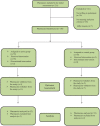Assessment of A new Strategy to Prevent Prescribing Errors Involving COVID-19 Patients in Community Pharmacies
- PMID: 36081535
- PMCID: PMC9445540
- DOI: 10.1177/00185787211073506
Assessment of A new Strategy to Prevent Prescribing Errors Involving COVID-19 Patients in Community Pharmacies
Abstract
Background: Because COVID-19 patients are vulnerable to prescribing errors (PEs) and adverse drug events, designing and implementing a new approach to prevent prescribing errors (PEs) involving COVID-19 patients has become a priority in pharmacotherapy research. Objectives: To investigate whether using WhatsApp to deliver prescribing error (PE)-related clinical scenarios to community pharmacists could enhance their ability to detect PEs and conduct successful pharmaceutical interventions (PIs). Methods: In this study, 110 community pharmacies were recruited from different regions across Jordan and equally allocated to 2 groups. Over the course of 4 weeks, WhatsApp was used to send PEs-related clinical case scenarios to the active group. The second group was controlled with no clinical scenarios. After completion of the 4-week phase, pharmacists from both groups were asked to document PEs in COVID-19 patients and their interventions using a data-collection form. Results: The incidence of PEs in COVID-19 patients documented in the active group (18.54%) was higher than that reported in the control group (3.09%) (P = .001). Of the 6598 and 968 PIs conducted by participants working in the active and control group pharmacies, 6013 (91.13%) and 651 (67.25%) were accepted, respectively. The proportions of wrong drug (contraindication), wrong drug (unnecessary drug prescribed/no proof of its benefits), and omission of a drug between the active and control groups were 15.30% versus 7.21% (P = .001), 11.85% versus 6.29% (P = .03), and 17.78% versus 10.50% (0.01), respectively. Additionally, the proportions of lethal, serious, and significant errors were 0.74% versus 0.35% (P = .04), 10.52% versus 2.57% (0.002), and 47.88% versus 9.57% (0.001), respectively. Addition of drug therapy interventions (AOR = 0.62; 95% CI, 0.21-0.84) and errors with significant clinical seriousness (AOR = 0.32; 95% CI, 0.16-0.64). Conclusions PEs involving COVID-19 patients in community settings are common and clinically significant. The intervention assessed in this study could be promising for designing a feasible and time-efficient interventional tool to encourage pharmacists' involvement in identifying and correcting PEs in light of COVID-19.
Keywords: COVID-19 patients; clinical scenarios; prescribing errors.
© The Author(s) 2022.
Conflict of interest statement
Declaration of Conflicting Interests: The author(s) declared no potential conflicts of interest with respect to the research, authorship, and/or publication of this article.
Similar articles
-
Pharmacists' interventions in prescribing errors at hospital discharge: an observational study in the context of an electronic prescribing system in a UK teaching hospital.Drug Saf. 2010 Nov 1;33(11):1027-44. doi: 10.2165/11538310-000000000-00000. Drug Saf. 2010. PMID: 20925440
-
Impact of Clinical Pharmacist Interventions in Prescribing Errors in Hospitalized Diabetic Patients with Major Polypharmacy.Hosp Pharm. 2021 Aug;56(4):392-399. doi: 10.1177/0018578720985428. Epub 2020 Dec 29. Hosp Pharm. 2021. PMID: 34381280 Free PMC article.
-
Description of pharmacists' reported interventions to prevent prescribing errors among in hospital inpatients: a cross sectional retrospective study.BMC Health Serv Res. 2021 May 6;21(1):432. doi: 10.1186/s12913-021-06418-z. BMC Health Serv Res. 2021. PMID: 33957900 Free PMC article.
-
Do community pharmacists influence prescribing?J Am Pharm Assoc (2003). 2003 Sep-Oct;43(5):612-21. doi: 10.1331/154434503322452256. J Am Pharm Assoc (2003). 2003. PMID: 14626754 Review.
-
Role of pharmaceutical care in therapeutic regimens within the community pharmacy.Ceska Slov Farm. 2023 Spring;72(2):70-78. Ceska Slov Farm. 2023. PMID: 37211427 Review. English.
Cited by
-
Investigating the point prevalence, types, severity, causes and predictors of vaccines administration errors during COVID-19 pandemic in Jordan.PLoS One. 2025 Jan 3;20(1):e0312050. doi: 10.1371/journal.pone.0312050. eCollection 2025. PLoS One. 2025. PMID: 39752371 Free PMC article.
-
Impact of the COVID-19 Pandemic on Pharmacist Interventions: A Retrospective Study with Inpatients in a University Hospital.Can J Hosp Pharm. 2024 Jul 10;77(3):e3514. doi: 10.4212/cjhp.3514. eCollection 2024. Can J Hosp Pharm. 2024. PMID: 38988873 Free PMC article.
-
Interventions to improve patient safety during the COVID-19 pandemic: a systematic review.BMJ Open Qual. 2025 Jun 30;14(2):e003076. doi: 10.1136/bmjoq-2024-003076. BMJ Open Qual. 2025. PMID: 40588397 Free PMC article.
References
LinkOut - more resources
Full Text Sources


